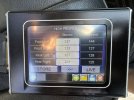feyniriel
Active Member
Hi, I'm not very familiar with EAS systems so pardon my newbie questions.
Ever since I bought my 1999 P38 (auto&2.5diesel) dash sometimes says "EAS fault" and the car would go to high setting. Usually after restarting the car, the issue resolved so I never looked into it.
Lately it started saying "EAS fault" while driving and lowering either the rear or front axle to access setting. This has caused problems on one instance when we were driving on a mountain road and had to pull over as the car wouldn't raise back up. That time restarting didn't work. We tried disconnecting battery, going to EAS menu on Nanocom, pressing "lift to standard height" which did nothing. There were some fault codes, one "front right valve permanently closed" and "unknown fault code". I deleted the fault codes, restarted the car, waited 5min with a door open (as I read this gives the compressor power to lift the car) and pressed "lift to high" which lifted it to standard height and we managed to keep driving.
Another time it went into access mode upon parking in town, but after returning in 30mins and restarting, EAS was working again.
What could be causing this? A while ago if I left the car in high setting overnight, it wouldn't lower. I think that meant it holds air well or something? It has also often given error codes claiming that the height sensors are out of range. Usually when we start it, the EAS lights are all on and if you start driving right away, it goes into a setting and works normally. However if you idle for a while, it gives EAS fault which won't get resolved until restarting.
We just pulled it in the garden to check some fluids underneath and it lowered itself again, can't reach under it now and EAS only goes to normal (sometimes) if it's driven for some tens of meters. Worth mentioning that the heights aren't calibrated, the target heights are all over the place. Could this be the culprit? Thanks guys.
Ever since I bought my 1999 P38 (auto&2.5diesel) dash sometimes says "EAS fault" and the car would go to high setting. Usually after restarting the car, the issue resolved so I never looked into it.
Lately it started saying "EAS fault" while driving and lowering either the rear or front axle to access setting. This has caused problems on one instance when we were driving on a mountain road and had to pull over as the car wouldn't raise back up. That time restarting didn't work. We tried disconnecting battery, going to EAS menu on Nanocom, pressing "lift to standard height" which did nothing. There were some fault codes, one "front right valve permanently closed" and "unknown fault code". I deleted the fault codes, restarted the car, waited 5min with a door open (as I read this gives the compressor power to lift the car) and pressed "lift to high" which lifted it to standard height and we managed to keep driving.
Another time it went into access mode upon parking in town, but after returning in 30mins and restarting, EAS was working again.
What could be causing this? A while ago if I left the car in high setting overnight, it wouldn't lower. I think that meant it holds air well or something? It has also often given error codes claiming that the height sensors are out of range. Usually when we start it, the EAS lights are all on and if you start driving right away, it goes into a setting and works normally. However if you idle for a while, it gives EAS fault which won't get resolved until restarting.
We just pulled it in the garden to check some fluids underneath and it lowered itself again, can't reach under it now and EAS only goes to normal (sometimes) if it's driven for some tens of meters. Worth mentioning that the heights aren't calibrated, the target heights are all over the place. Could this be the culprit? Thanks guys.


